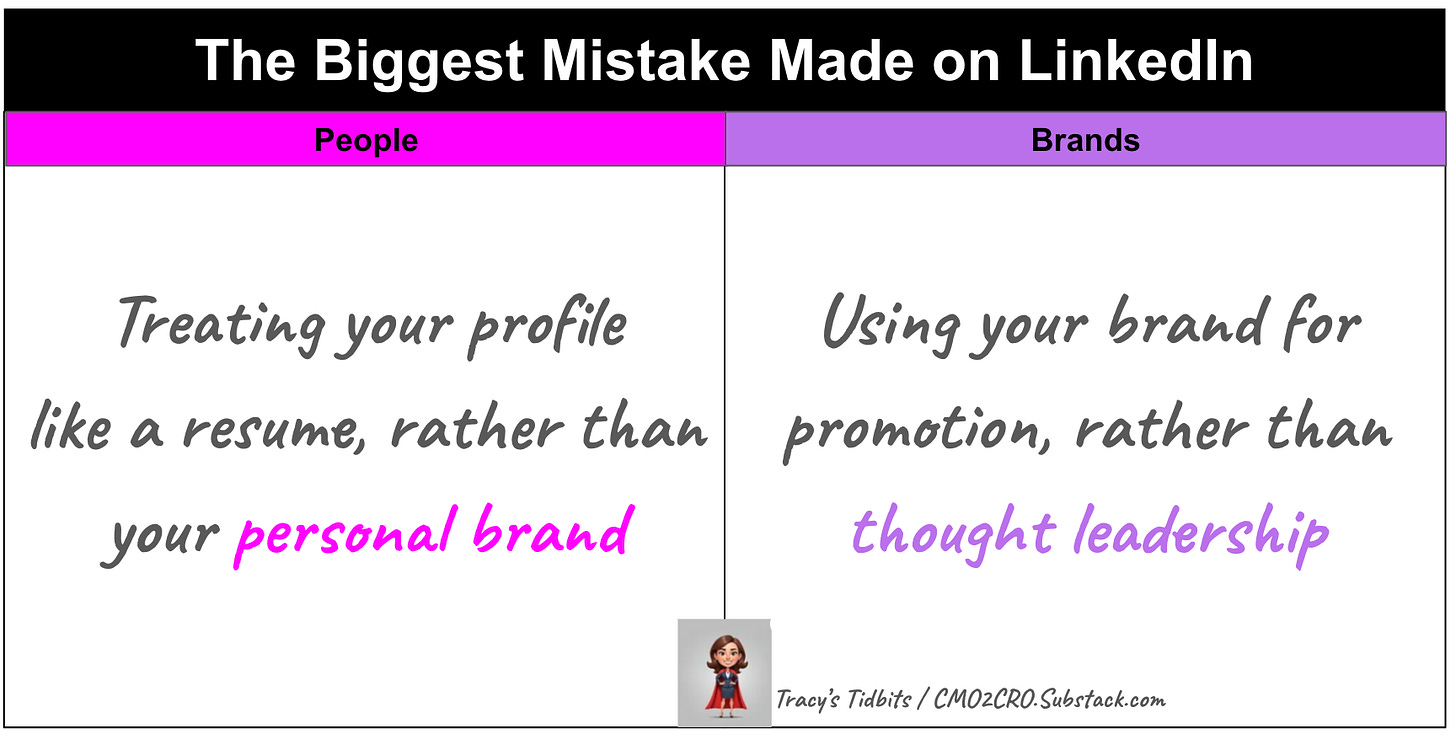If you remember anything from this post, remember this:
The difference between marketing yourself vs your company’s brand on LinkedIn
👉 Your personal brand is about making connections.
👉 Your company brand is about building thought leadership.
👉 Both build trust and credibility over time.
INDIVIDUALS
The biggest mistake I see individuals make on LinkedIn is treating their profile like a resume, rather than their personal brand. When people look someone up on Google, LinkedIn comes up toward the top, often usually first, and it’s all due to their SEO juice.
LinkedIn has:
High domain authority (98+) which makes its pages highly favored by Google and other search engines
Strong backlinks: millions of sites link back to LinkedIn building it’s credibility and authority
Structured data and optimization (schema markup) that helps search engines understand the content clearly (includes things like names, job titles, locations, and more)
Exact Match Relevance: Your name is prominently featured in the page title, meta description, and headers of your LinkedIn profile—critical factors for SEO when someone searches for your name
Regularly Updated Content: LinkedIn profiles are frequently updated with new positions, posts, endorsements, and activity, signaling to Google that the page is fresh and relevant
Search Intent Alignment: Google recognizes that when someone searches for a name, they’re often looking for professional information and LinkedIn directly satisfies that search intent
PROOF POINT #1 - Personal Brand
Recently I met a new friend, Christine, at the hair salon. She was lovely and I really enjoyed our convo, but felt awkward to ask her for her contact info. Two hours later I get a LinkedIn messages from her saying, “it was so good meeting you today!” Turns out she thought I looked familiar and then remembered she had seen me on CMO Coffee Talk, a Slack group created by Latane Conant and Matt Heinz five years ago. And, she had just subscribed to this newsletter. What a small world! When I asked her how she found me, she said she knew my name was Tracy, so she did a search in her inbox and found Tracy’s Tidbits, then she did a Google Search and up came my LinkedIn profile as one of the first things.
BRANDS
The biggest mistake I see brands make on LinkedIn is using their brand for promotion, rather than thought leadership. CMOs feel like they are forced to have a loud, bold voice and an engaged community on every social platform. It’s a ‘say and spray’ method every time there is a new ebook or webinar. Plus tons of photos of off-sites and employee gatherings. This is what LinkedIn company pages have unfortunately become.
PROOF POINT #2 - Company Brand doing it Right
HubSpot is a great example of using thought leadership over just strictly promotion. HubSpot regularly posts valuable content catered to their audiences on inbound marketing, sales, and customer success. They balance educational content, actionable insights, and engaging personal posts. Their consistent use of LinkedIn articles and thought leadership pieces establishes their authority in the marketing and sales space.
Below is a LinkedIn post example from HubSpot CEO, Yamini Rangan, where she talks about how they use AI to combat customer support tickets.
Company Pages on LinkedIn
LinkedIn’s search algorithm prioritizes company profiles that are complete with all business details. In fact, companies with complete information get 30% more weekly views on average.
Articles or Newsletters (which are just collections of Articles), and even Live Events on LinkedIn can help create and boost thought leadership for your company brand
Remember, your company page is your free billboard to say what you do and why others should buy your product.
CxOs of Brands
There is so much opportunity for CxOs to become thought leaders. When doing so they boost the brand they work for. The problem is most CxOs write their LinkedIn posts as thinly veiled sales pitches. By doing this they lose credibility for themselves and in their brand because it screams “desperate.”
“Most CEOs write their LinkedIn posts as thinly veiled sales pitches,”
— Tracy Sestili, CMO/CRO
Recently a female CEO who I respect a lot posted a LinkedIn post that was just that — a thinly veiled sales pitch. I’m used to seeing this from our favorite bro-etry clan (IYKYK), but not from female CEOs.
Her post started out strong and had really good, helpful advice within it, but in the middle was a “sales sandwich” on how they use their own product to solve the problem she was addressing. 📣 There will be plenty of opportunities for her to tell this particular story in an interview or case study. This post was not the time. 📣
I forwarded her back her post and edited it down from 363 word sales pitch to 103 word helpful post.
There is a time and place for founder led sales, LinkedIn is neither.
p.s. next week I’ll be doing a post on growth vs demand gen and why you need both and how you should set your org structure to accommodate.





